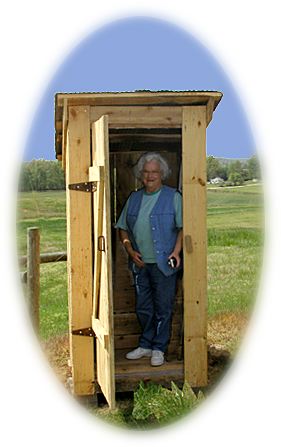Pictoral History of the
Family Farm
by MaryCarol
![]()
Pictoral History of the
Family Farm
by MaryCarol
![]()
|
Page 1 Page 2 Page 3 |
 |
|
|
|
Outhouse Trivia Just about everything you ever wanted to know The average outhouse was 3 to 4 feet square by 7 feet high. It had no window, no heat, no electric light. Most outhouses were built between 50 and 150 feet from the main house, often facing away from the house. Since the odor of the outhouse was so unpleasant, many people left the door open - facing the woods - while they were using it. Old-timers admit that they had trouble breaking this habit with the invention of indoor bathrooms. The crescent moon cutout and the star cutout on the door of many outhouses goes back to Colonial times. In a time when few people could read, the crescent moon was the symbol for women while the star cutout was for men. Outhouses were designated by the moon or star. It is thought that the men, in general, let their outhouses fall into such bad shape that it was the women's outhouses that survived the test of time. The cutout also let light into the outhouse as there were no windows. Outhouses were set over a hole, about 5 feet deep. When it was full, another hole was dug nearby and the old hole was filled up with dirt. These sites are now places of historical interest - no joke - since the outhouse hole was a popular place to throw away trash. Archeologists look for these dump sites to find old bottles, pottery, etc. Most outhouses were "one-holers" but big families often had "two-holers" or even "three-holers". There was a hotel in Montana that had an outhouse with 12 seats. There were even 2 story outhouses that were built so when the snow piled up beyond the first floor, one could still get to the outhouse. During Rossevelt's Works Progress Administration - the WPA - there were teams of outhouse builders who built most of the outhouses in rural areas. Outhouses were easy to build, nothing more than a wooden shack, a two-foot bench with a hole in it, and a door that swung IN....didn't want to surprise anybody. Some outhouses had a chicken switch hanging on a hook. It was used to swat the flies and other varmints. Some outhouses had a bucket of lime nearby as well. The lime was used to help with the smell of the outhouse. Toilet paper was considered a luxury, so most rural families used newspaper or pages from old catalogs....like the sears catalog. The outhouse has been called many names. It is know as the Little Brown Shack, the Privy, the Backhouse and Earth Closet. Modern toilets have been called the Water Closet, the Convenience, the Rest Room, the Ladies Room or Mens Room, the Lavatory, the Washroom, Bathroom, the Comfort Station, the Powder Room, the Head, the Necessary Room, the John or Johnny, the Can, the Commode, the Throne, or the Crapper. The word Crapper comes from plumbing inventor, Thomas Crapper.
|
|
THE OUTHOUSE POEM
The service station trade was slow
No modern facilities had they,
"Where is the ladies restroom, sir?"
With quickened step she entered there
With startled look and beet red face
She missed the foot log - jumped the stream
She tripped and fell - got up, and then
Of course we all desired to know
A speaking system he'd devised
He'd wait until the gals got set
And as she sat, a voice below
House Behind the House The Shanty One of my bygone
recollections Ours was a three-holer,
Oft times in dead of
winter, I recall the day Grandpa,
Now Grandpa had an
urgent call, The Blast that followed,
I am
sure When we asked him what
had happened, Now that's the end of
the story, Submitted by
Billie Kirk |
![]()
BACK
to Family Farm Life page
BACK to Weakley County Home Page
Webpage Design & Photo Graphics by
MaryCarol © 2003